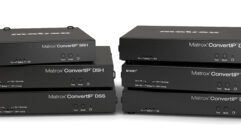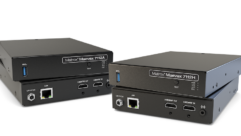
Technology Showcase: Video Over IP
Nov 1, 2008 12:00 PM,
By Jay Ankeney
The latest hardware-based technology simplifies video distribution.

NetStreams DigiLinX
To show how far the Internet has progressed, consider that in the March 1946 issue of Astounding Science Fiction magazine, Murray Leinster described its basic concept with humor and foresight in a sci-fi story called “A Logic Named Joe.” Its plot involves a “logic” (personal computer) who scrambles “the tank” (precursor to the World Wide Web), which creates chaos by flooding the system with an overload of unfiltered information. Of course, back then, the whole idea of PCs and the Internet were mere figments of the imagination. Today, they are cornerstones of our daily existence.
The Internet is so ubiquitous that everyone is using Internet Protocol (IP) intuitively to distribute text and files; although few bother to understand how it functions. In recent years, however, the potential of using IP to also send the larger throughput requirements of video to multiple recipients has begun to permeate the corporate and institutional community as an increasingly viable alternative to the current Asynchronous Transfer Mode (ATM).
The difference is significant. ATM creates a virtual circuit before the data exchange begins that is based on standards created in the mid ’80s by the International Telecommunications Union and augmented, starting in 1991, by the ATM Forum (now merged into the IP/MPLS Forum). It is a core protocol used in the Synchronous Optical Networking/Synchronous Digital Hierarchy (SONET/SDH) backbone of the public switched telephone network run by telcos. Therefore, you have to pay for it.

Computer Modulues OnRamp IP/Sat
IP, on the other hand, sends information in packets over the free public Internet or a relatively inexpensive private intranet, and therein lies both the advantage and the challenge. IP had many fathers, but a significant milestone was a paper published in May 1974 by Vinton G. Cerf and Robert E. Kahn titled “A Protocol for Packet Network Interconnection.” Cerf and Kahn laid out a methodology for sharing information over a network in the form of packets or datagrams. This was later divided into an architecture consisting of a transmission control program at the connection-oriented layer and the Internet protocol at the internetworking layer. Hence, the term “TCP/IP,” or its more formal moniker, the “Internet Protocol Suite,” which separated the concept of the network from its physical implementation.
This makes the distribution of digital video to multiple recipients vastly simpler than during the days when RF-modulated analog video directed through routing switchers was the only practical option to a patch panel. Back then, every input and output required its own matrixed switch, but with an IP-based system, you only have to provide the specific number of encoders and decoders needed for each stream. If you need to add an additional source, just add an additional encoder.
Although massive amounts of information can be distributed quickly and easily to anyone with enough bandwidth accessing a local area network (LAN), wide area network (WAN), or the Internet (a network of networks sometimes referred to as “the cloud”), essential to the success of TCP/IP is that the material is being sent in packets. This is very efficient as long as the packets arrive in time and in their proper order. If they don’t, the audio/video information can be out of sync and, in the worst case, garbled. Keeping all that content together over a closed, internal IP network is fairly straightforward as long as professional encoders and decoders are implemented and the system’s capabilities are not exceeded. To achieve an acceptable quality of service (QoS) while sending all of those packets over the public Internet, some kind of buffering is required to maintain proper order in the parade of packets.
Technology Showcase: Video Over IP
Nov 1, 2008 12:00 PM,
By Jay Ankeney
The latest hardware-based technology simplifies video distribution.

Cabletime MediaStar Evolution
With the vast increase in bandwidth now available to people connected to either proprietary corporate networks or the public Internet, along with the improved efficiency of H.264 compression — which is also known as MPEG-4 Part 10 or AVC (Advanced Video Coding) — the capabilities of sending video over IP are growing rapidly. While not long ago it required a data-transfer rate of 5Mbps to transmit full-frame 30fps video, today, H.264 can send that same video quality at 1/10 the rate. As a result, applications including security cameras, digital signage, television news gatherers transmitting their stories back to the studio, and the weekly pep-talk ego-casts beamed from earnest CEOs to every division of their company are sending their video content over IP. Any grandma cooing over her daughter’s newborn being seen for the first time on a webcam is benefiting from video over IP.
The amount of video being sent over IP on any given day is impossible to quantify, but the market research firm Frost & Sullivan has been able to track the growth of IP-based video transport service providers in the broadcast industry. The company’s report, titled “U.S. Fibre-based Broadcast Video Transport Services Market” and released in March 2008, stated: “Never before have the terrestrial networks been in as much demand for transporting broadcast video content as they are now, which is largely due to the emergence of Internet Protocol/Multiprotocol Label Switching (IP/MPLS) backbones and next-generation transport technologies such as the Ethernet. The U.S. broadcast-video transport services market generated revenues worth over $200 million in the year 2007, and the market revenues are expected to exceed $600 million in 2012.”
When it comes to global IP video traffic, on June 16, Cisco released a white paper titled “Approaching the Zettabyte Era.” (A zettabyte equals one sextillion bytes or 1021.) In it, Cisco reported that “Internet video is now approximately one-quarter of all consumer Internet traffic, not including the amount of video exchanged through P2P file sharing. Internet video was 22 percent at the end of 2007, and will reach 32 percent by the end of this year. The sum of all forms of video (TV, VoD, Internet, and P2P) will account for close to 90 percent of consumer traffic by 2012. Internet video alone will account for nearly 50 percent of all consumer Internet traffic in 2012.”
Although discussing the topic of video over IP is as broad as analyzing ships on the ocean, we are going to look at examples of hardware-based technology selected from a variety of sources of potential interest to systems integrators and their corporate clients to take measure of the scope of its possibilities. Granted, that harks to the ancient fable of blind monks examining an elephant, but that is, in reality, just a reflection of the power of Internet Protocol and the mystery of whole Internet itself. Remember, though, that in the end, it is just an elephant.
After it acquired Atrium Group Developments in June of this year, AMX launched Atrium’s seventh-generation IPTV system, rebranded Vision2. (Although crowned with a superscript “2”, the product is pronounced “Vision Two.”) The AMX Vision2 system enables you to capture, store, retrieve, and distribute live and archived content to meet a variety of video needs via the Internet or an intranet with the help of five built-in applications. V2 Live captures, encodes, multicasts, unicasts, or streams live video content in MPEG-2, MPEG-4, or WMV formats. V2 Record records the video and stores it in V2 Archive for future viewing. V2 Archive then allows you to store and manage videos in Flash, WMV, MPEG-2, and MPEG-4 format. V2 Archive has an integrated search feature that allows you to find content based on titles and metadata. V2 Producer enables the scheduling of prerecorded video for timed playback over IP. Finally, V2 On Demand provides users with the ability to watch video content stored in the V2 Archive whenever they want with simple browsing and search features.
Technology Showcase: Video Over IP
Nov 1, 2008 12:00 PM,
By Jay Ankeney
The latest hardware-based technology simplifies video distribution.

Sony NSR-1200
The leader in the IP-based security camera market is Axis Communications for both networked cameras and video encoders, having developed the world’s first IP-based network camera in September 1996. Today, Axis Communications has around 1 million professional network video products and more than 3 million networking products installed worldwide. The Axis P3301 is a fixed-dome network camera capable of providing multiple H.264 streams as well as Motion-JPEG streams simultaneously in either full frame rate or individually optimized to service different quality needs and bandwidth constraints. The company’s Axis Q7401 video encoder can deliver multiple, individually configurable video streams simultaneously at full frame rate in all resolutions up to D1 (720×480 in NTSC or 720×576 in PAL). It offers highly efficient H.264 video compression, which drastically reduces bandwidth and storage requirements without compromising image quality, and Motion JPEG for increased flexibility.
The MediaStar Evolution IPTV encoders from Cabletime generate either a single MPEG-2 or MPEG-4 dual-output encoded stream to ensure best performance while minimizing the impact on the network. A high-bit-rate stream directs video to large displays where vision quality is paramount while a second lower-bit-rate stream is simultaneously encoded and can be directed to desktop PCs and small displays where lower resolution is acceptable. Able to be installed in a plug-and-play manner to deliver video and audio instantly, MediaStar Evolution 775 encoder converts analog video and audio signals to MPEG-2 or MPEG-4 digital signals and streams them over a LAN/WAN data network. New in the MediaStar Evolution family of IP products is the DVB-T LAN-Caster, a terrestrial (DVB-T) to LAN (IP) gateway system. The LAN-Caster receives digital terrestrial off-air DVB signals, extracts the digital data out of the MPEG-2 streams, and repacketizes the data in a format suitable for transmission over an IP-based network/LAN.
As the first teleconferencing system to provide bidirectional realtime 1080p video over IP in 2006, Cisco has established itself as a leader in the race toward true telepresence as well as providing advanced security camera systems. Cisco Enterprise TV enables on-demand video and live-broadcast TV channels to be delivered over IP to digital displays. Built on the power of the Cisco Digital Media System 5.0 that was released last July, Cisco Enterprise TV leverages the same hardware and management platform as Cisco Digital Signage. It can also interoperate with Cisco Digital Signage or operate as a standalone application. Users get access to Enterprise TV content through onscreen menus and program guides, and organizations can customize lineups and create their own content libraries.
Cisco is also on the forefront of monitoring analog and digital security cameras. The Cisco Video Surveillance IP Gateway video encoders and decoders use a high-quality MPEG-4 video-compression technology that allows video streams to be switched over the IP network at up to full-D1 resolution and up to 30fps, while consuming little bandwidth. Its video encoder connects to an analog video camera and simultaneously encodes two MPEG-4 video streams at different resolutions and frame rates, allowing for high-quality live viewing while recording at lower frame and bit rates for longer storage time. The system’s video decoder can be installed anywhere there is a need for live viewing or playback of recorded video on an analog closed-circuit television (CCTV) monitor. Controlled by Cisco Video Surveillance Stream Manager software, the Video Surveillance IP Gateway enables you to connect even your analog surveillance equipment to a digital network.
Introduced at IBC 2008, the OnRamp IP/Sat from the DVEO division of Computer Modules is a rackmount, Linux-based satellite-to-IP gateway that integrates one to four satellite-based receivers and demodulates, routes, and optionally transcodes into H.264 compression. With OnRamp IP/Sat, the desired streams are sent in realtime using the User Datagram Protocol (UDP) or Realtime Transport Protocol (RTP) via IP multicast or unicast streams to IP set-top boxes (STB) such as those from the world’s largest provider of STBs, Amino, or designated VideoLAN Client (VLC) or Mplayer-equipped PC clients for viewing. The company also offers the IP Caster FD, an IP gateway that connects high-definition digital video equipment to computer networks over the Internet. It converts HD MPEG-2 transport streams from DVB-ASI to IP in realtime and transmits HD MPEG-2 transport streams over Ethernet-based IP networks and converts them back to DVB-ASI.
Technology Showcase: Video Over IP
Nov 1, 2008 12:00 PM,
By Jay Ankeney
The latest hardware-based technology simplifies video distribution.
The IP-based and IP-controlled systems from NetStreams are designed to handle virtually any number of digital or analog sources and to deliver uncompressed content, including high-definition audio and video, to an virtually unlimited number of zones. By combining content and control signals in one data stream, NetStreams systems offer improved levels of simplicity, reliability, and expandability that can benefit both integrators and users with lower costs for installation, setup, and support.
DigiLinX is NetStreams’ IP-based audio/video distribution network designed to deliver the highest-quality transmission over the same network infrastructure found in most commercial facilities today. DigiLinX requires only a single Cat-5e cable to deliver audio, video, and control. DigiLinX also provides many options for controlling an audio/video distribution solution, from its built-in GUI to drivers for Crestron and AMX systems. Integrators and application partners can even control DigiLinX through custom-built applications.
A very significant implementation of video over IP is to bring images from security cameras back to centralized monitors, and Sony was one of the first major companies to adopt this approach. Its SNT-V704 is a compact video network station that enables a video camera with an IP interface to be remotely monitored and controlled over a network. It enables analog camera monitoring at 30fps, and it offers selectable MPEG-4/JPEG compression formats. The SNT-V704 has a Tour feature with five scanning patterns with up to 16 positions in each scan and an Area Setting feature that allows the administrator to crop an area within an image.
Just last September, Sony added three hybrid video network surveillance recording servers to its line: the NSR-1050H, the NSR-1100, and NSR-1200. These new recording servers come with enhanced features, including the ability to combine analog and IP cameras on one system, full high-definition video output (1920×1080), and open-platform operation that supports cameras from multiple vendors. The NSR-1050H, NSR-1100, and NSR-1200 units have internal storage of up to 0.5TB, 1TB, and 2TB, respectively. Each server can be connected with up to seven NSRE-S200 storage units, which provides an additional 2TB of hard-disk storage
Typically used for mobile newsgathering, the ACT-L3 Portable Video Transport system from Streambox enables broadcasters, government agencies, and enterprises to deliver high-quality live and stored broadcast video over low-data-rate connections such as broadband, BGAN, and other IP and satellite networks. During electrical outages, Streambox systems seamlessly switch to battery power and continue to deliver video without interruption. Houses of worships have even used the ACT-L3 system to send live reports back to the congregation from missionaries serving in the field. Streambox’s ACT-L3 codec features an advanced proprietary video compression technology that has been optimized for interlaced video and provides more efficient compression than MPEG and H.264. ACT-L3 is highly adaptable to differing data-rate requirements.
As major proponents of Video Streaming as a Service (VsaaS), VBrick has set its sights on making it possible for even the smallest organizations to achieve the kind of video broadcasting reach once only available to large corporations. In fact, its website proclaims, “It is now possible to setup a worldwide broadcast-capable Internet TV station for a few thousands of dollars.”
Its VBoss system is a family of VSaaS products to facilitate streaming video assets out to the Internet that includes VBoss Engage, VBoss Broadcast, and VBoss Present. VBoss Engage is a comprehensive video service that instantly delivers live video from anywhere at any time and displays it on a customized viewing portal with the sender’s private branding. This delivery can be either a free, advertising-supported, or pay-per-view broadcast. VBoss Broadcast lets you cut and paste code to insert live video into your own website while also providing template-based viewing pages. VBoss Present enables anyone to plug in a camera and give PowerPoint presentations to a global audience from a desktop.
Technology Showcase: Video Over IP
Nov 1, 2008 12:00 PM,
By Jay Ankeney
The latest hardware-based technology simplifies video distribution.
VBrick also offers its EtherneTV Portal Server, an in-house web-based portal for accessing live streams and on-demand AV assets. The user interface of VBrick’s EtherneTV Portal Server provides the ability to locate available media assets from Windows PCs, Macs, Linux PCs, and IP receivers. It can generate automated live channel guides and navigation to video-on-demand assets. It supports Windows Media; MPEG-1, -2, and -4 compression; 4X3 and 16X9 aspect ratios; PAL and NTSC formats; and full-screen video up to DVD quality.
ViewCast‘s product family is designed to meet the requirements of delivering live 24/7 streaming video, as well as on-demand video over IP and mobile networks. The company’s lineup includes Niagara streaming encoders, Osprey video capture cards, and ViewCast software. The Niagara family of streaming media encoders have been optimized to be reliable, pre-configured, plug-and-play encoders that enable you to quickly encode and stream premium-quality audio and video over corporate or mobile networks as well as the public Internet. Osprey video cards capture, digitize, compress, decompress, and display full-motion video in realtime. ViewCast software includes Niagara SCX control and management software and Niagara SCX SDK development software, as well as Osprey SimulStream. The Niagara SCX SDK (Software Developers Kit) allows you to integrate the SCX software into your own applications and services.
MORE INFORMATION
AMX
www.amx.com
Axis Communications
www.axis.com
Cabletime
www.cabletime.com
Cisco
www.cisco.com
Computer Modules
www.computermodules.com
NetStreams
www.netstreams.com
Streambox
www.streambox.com
VBrick
www.vbrick.com
ViewCast
www.viewcast.com










